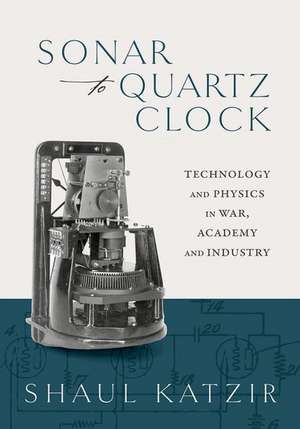Sonar to Quartz Clock: Technology and Physics in War, Academy, and Industry
Autor Shaul Katziren Limba Engleză Hardback – 7 sep 2023
Preț: 326.75 lei
Preț vechi: 352.28 lei
-7% Nou
Puncte Express: 490
Preț estimativ în valută:
62.52€ • 65.28$ • 51.63£
62.52€ • 65.28$ • 51.63£
Carte disponibilă
Livrare economică 14-20 martie
Livrare express 08-14 martie pentru 69.52 lei
Preluare comenzi: 021 569.72.76
Specificații
ISBN-13: 9780198878735
ISBN-10: 0198878737
Pagini: 368
Ilustrații: 25 illustrations
Dimensiuni: 174 x 248 x 37 mm
Greutate: 0.75 kg
Editura: OUP OXFORD
Colecția OUP Oxford
Locul publicării:Oxford, United Kingdom
ISBN-10: 0198878737
Pagini: 368
Ilustrații: 25 illustrations
Dimensiuni: 174 x 248 x 37 mm
Greutate: 0.75 kg
Editura: OUP OXFORD
Colecția OUP Oxford
Locul publicării:Oxford, United Kingdom
Recenzii
Covers an extremely rich case of interplay between science and technology, and greatly contributes to correcting the common prejudice that relativity and quantum physics were the sole important innovations of the early twentieth century.
Examines in fascinating detail how the phenomenon of piezoelectricity was transformed from so-called pure physics to technically useful devices. Clearly written and well structured, and of high scholarly quality.
A fresh and insightful approach to the ways in which physics, technology, and innovation are entangled.
Provides a substantial case study that casts new light on the scholarship of the science-technology relationship and uses some of its major findings to further the understanding of the process of technological innovations.
For anybody interested in the case of piezoelectricity, however, this book is essential reading.
The history of piezoelectricity provides a rich field for studying the intricate relationships between scientific and technological lines of knowledge creation and application. Readers... [will] rate [Sonar to Quartz Clock] clearly among the best scientific work on the subject.
Examines in fascinating detail how the phenomenon of piezoelectricity was transformed from so-called pure physics to technically useful devices. Clearly written and well structured, and of high scholarly quality.
A fresh and insightful approach to the ways in which physics, technology, and innovation are entangled.
Provides a substantial case study that casts new light on the scholarship of the science-technology relationship and uses some of its major findings to further the understanding of the process of technological innovations.
For anybody interested in the case of piezoelectricity, however, this book is essential reading.
The history of piezoelectricity provides a rich field for studying the intricate relationships between scientific and technological lines of knowledge creation and application. Readers... [will] rate [Sonar to Quartz Clock] clearly among the best scientific work on the subject.
Notă biografică
Professor Shaul Katzir is the director of the Cohn Institute for the History and Philosophy of Science and Ideas at Tel Aviv University, Israel. His scholarly interests range from ancient Greek science to twentieth century physics and technology. He has published extensively on the history of the physical sciences, connected technologies and their interactions in the nineteenth and twentieth centuries in leading venues. Katzir earned an MA (1996) and a PhD (2003) at Tel Aviv University. Before returning to his alma matter he was fellow of (among others) the Hebrew University, the Humboldt Foundation, the European Research Council, and the Max Planck Institute for the History of Science, where he is a regular visitor.
